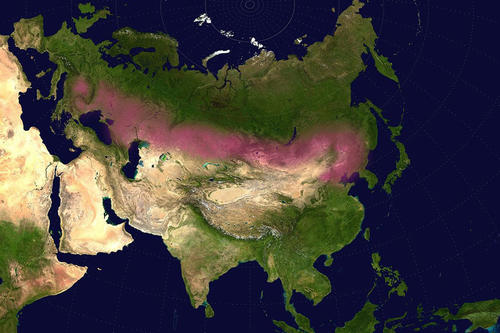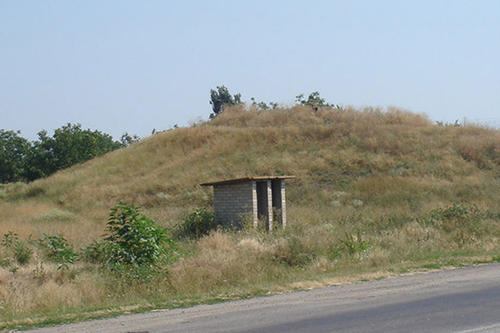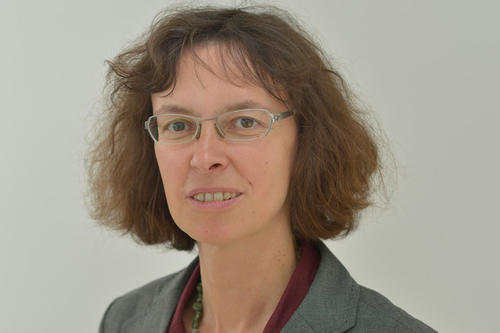Exploring a Vast Territory
Elke Kaiser holds Germany’s only professorship in the archaeology of Eurasia.
Jul 14, 2015
The Eurasian steppe stretches from Eastern Europe to the northeast of the Asian continent.
Image Credit: Creating User Cp6 / Original: NASA’s Blue Marble Project
This photo shows a kurgan, a burial mound, in the Eurasian steppe.
Image Credit: Claudia Gerling
Elke Kaiser holds Germany’s only professorship in the archaeology of Eurasia.
Image Credit: Bernd Wannenmacher
The region whose prehistory Elke Kaiser studies is an inhospitable one. Kaiser, an archaeologist who studies how the inhabitants of the Eurasian steppe lived more than 5,000 years ago, says, “We still know very little about it.” Starting this year, Kaiser holds Germany’s only professorship in the archaeology of Eurasia, a position established with funding from the Topoi cluster of excellence at Freie Universität.
So far, Kaiser says, burial mounds from this period have been a major focus of excavation work, but not settlements. Some of these attest to an unusual lifestyle: People lived in small, temporary villages that they moved every few months, following a rhythm that has not yet been identified. They packed up everything – including children and livestock – and moved to a different location just under two kilometers away, cycling through various other sites before returning to the original spot.
Research on the area has been spotty so far for a number of reasons. First, the material remains of early settlement – what Kaiser calls a “multidimensional puzzle” that she pieces together – are meager. And then there is the history of the 20th century and how it affected countries like Ukraine, Moldova, and Russia. Eurasia stretches over a vast expanse of land from the Black Sea all the way to Siberia and China.
When the Soviet Union still existed, there was little scientific or research exchange with Western countries, but archaeologists did do research and were engaged in rescue excavation as part of fixed positions at research institutions such as museums and universities. The 1991 breakup of the Soviet Union brought a dramatic change in the situation for scholars.
Archaeologist and Scholar of Slavic Languages and Literatures
Kaiser saw for herself what this break meant to her colleagues in the area in the mid-1990s, when she traveled to Kiev for the first time after completing her master’s thesis. She had studied Slavic languages and literatures alongside archaeology and had learned Russian – “a wonderfully beautiful language” – even before starting college. But now she was faced with a research system in flux. “No one knew what would happen,” she explains. Researchers had two or three jobs because their actual work was no longer enough to feed their families.
The situation has changed in the meantime, and there are numerous cooperative initiatives in place with scholars and institutions in Western countries. One body that was instrumental in developing these arrangements was the Eurasia Department, founded in 1995, of the German Archaeological Institute (DAI). The DAI is one of the cooperation partners of the Topoi cluster of excellence, a joint research alliance between Freie Universität and Humboldt-Universität. The department was initially headed by founding director Hermann Parzinger – currently the president of the Stiftung Preußischer Kulturbesitz (Prussian Cultural Heritage Foundation) – and since 2003 has been led by Svend Hansen; both archaeologists are also involved in Topoi through research projects.
War in Ukraine Has Devastating Effects on Academic Communication
But 20 years after the department was founded, the region that is the focus of its research once again faces major problems. “The war in Ukraine is having a devastating effect on communication between Ukrainian and Russian scholars and researchers,” Kaiser says. She says it will take a generation to repair the ties that have been destroyed in just one year.
And yet, archaeological investigation of the Eurasian double continent represents a huge opportunity. The vast territory of Eurasia, Kaiser says, offers a different cultural history to discover than Central or Southern Europe. She also says that the fall of the Iron Curtain has made it possible “to start a new chapter in research on prehistory.”
Further Information
Elke Kaiser, Department of History and Cultural Studies, Tel.: +49 30 838 51792, Email: ekaiser@zedat.fu-berlin.de



